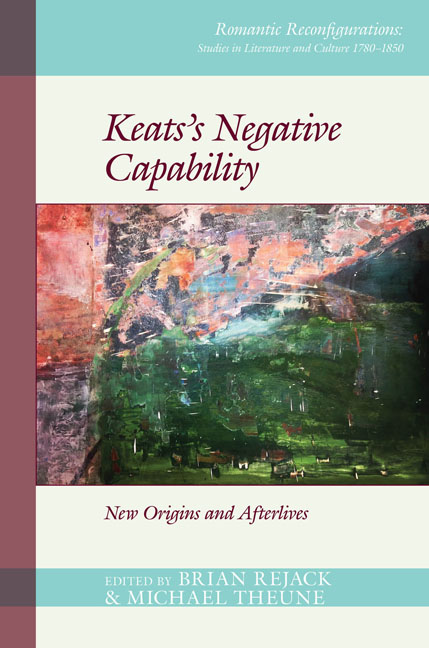Book contents
- Frontmatter
- Contents
- List of Figures
- Acknowledgments
- List of Abbreviations
- List of Contributors
- Preface
- Introduction: Disquisitions: Reading Negative Capability, 1817–2017
- Part I ‘swelling into reality’: New Contexts for Negative Capability
- Part II ‘examplified throughout’: Forms of Negatively Capable Reading
- Part III ‘pursued through Volumes’, Volume I: Negative Capability in Twentieth- and Twenty-First-Century American Poetry
- Part IV ‘pursued through Volumes’, Volume II: Adaptations, Appropriations, Mutations
- Afterword: Reading Keats's Negative Capability
- Bibliography
- Index
Preface
- Frontmatter
- Contents
- List of Figures
- Acknowledgments
- List of Abbreviations
- List of Contributors
- Preface
- Introduction: Disquisitions: Reading Negative Capability, 1817–2017
- Part I ‘swelling into reality’: New Contexts for Negative Capability
- Part II ‘examplified throughout’: Forms of Negatively Capable Reading
- Part III ‘pursued through Volumes’, Volume I: Negative Capability in Twentieth- and Twenty-First-Century American Poetry
- Part IV ‘pursued through Volumes’, Volume II: Adaptations, Appropriations, Mutations
- Afterword: Reading Keats's Negative Capability
- Bibliography
- Index
Summary
Negative capability came out of moonlight, somewhere on the cursed cold distance between London and Hampstead. Nothing is known about precisely where and when, but there are a few bearings that we can establish. Keats was at the Reynolds’ home in Lamb's Conduit Street, Bloomsbury, on Christmas Eve of 1817: his friend John Hamilton Reynolds would shortly leave town and asked Keats to take his place and review a new pantomime at Drury Lane. On Christmas day Keats returned to Hampstead, encountering William Godwin on the way, and passed the evening at Wentworth Place with his friends Brown and Dilke. Next day, a Friday, all three of them set off for town and the first performance of ‘a new splendid pantomimic Romance called HARLEQUIN’S VISION; or, The Feast of the Statue’. That night a holiday audience was in tumultuous mood, pelting the actors with ‘discharges of oranges’ and eliciting ‘a just and effective appeal’ from the stage. Keats's satirical review appeared in The Champion on 4 January and a full account of the performance he saw survives in the Morning Post.
Based on the story of Don Juan, Harlequin's Vision opened with ‘a grand and terrific view of Pluto's Council Hall’. The ghost of the Don's father, introduced by Mercury, implores Pluto's mercy for his son, whose dissolute life ‘bids fair to send him to Tartarus’. When his request is rejected, Proserpine intervenes and
dispatches Mercury to Venus; and these three deities uniting their efforts, lead Don Juan in a dream (which to the spectators is the reality of the Pantomime) through all the vicissitudes of guilt, audacity, and punishment, which usually marks the career of the libertine. After having been thrown into an ocean of living flame, he is again found on his sofa, awakened by Venus, and restored a reclaimed husband to the arms of his forgiving wife.
This performance of dream reality featured many splendid scenes—a temple of Venus descending through opening clouds, an amphitheater, a cemetery by night:
the passage of the Acheron under stupendous arches of rocks, with the distant view of the burning mountain, is full of wildness and majesty; and the Pandemonium or palace and sea of fire, is a terrific representation of all that can be conceived of Hell.
- Type
- Chapter
- Information
- Keats's Negative CapabilityNew Origins and Afterlives, pp. xvii - xxiiPublisher: Liverpool University PressPrint publication year: 2019



